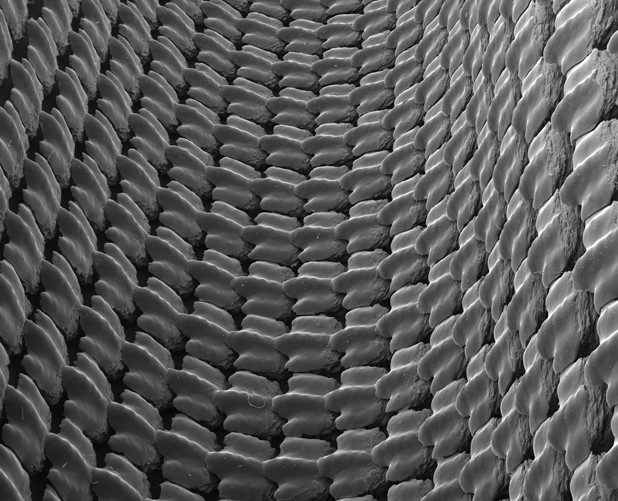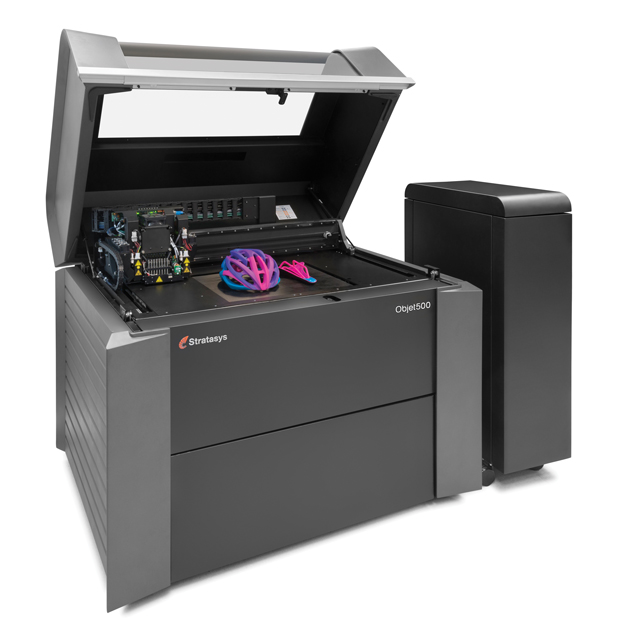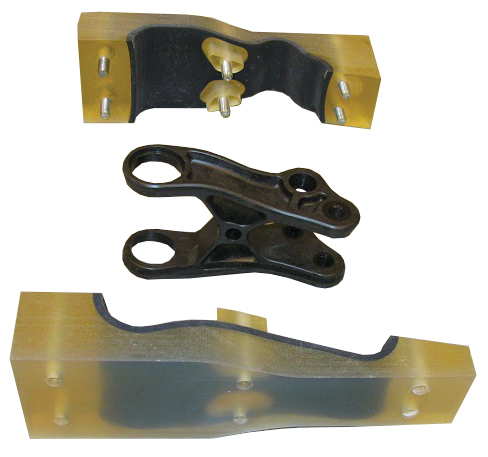Multiply 3D Printing’s Material Benefits

Multi-material 3D printing is a game changer for Trek, allowing it to push designs further. Image courtesy of Trek Bicycle.
Latest News
September 1, 2015
 The team at Wyss Institute was able to replicate the unique structure of shark skin by incorporating multiple materials into a single 3D printed model. Image courtesy of Wyss Institute.
The team at Wyss Institute was able to replicate the unique structure of shark skin by incorporating multiple materials into a single 3D printed model. Image courtesy of Wyss Institute.There’s not much that inspires the same levels of fear and awe as a shark. Its menacing dominance of the sea might only be eclipsed by its swimming prowess—performance that researchers are striving to replicate for aerodynamic applications in industries such as aerospace and the marine sector.
The research team at the Wyss Institute for Biologically Inspired Engineering at Harvard University knew that the shark’s flexible skin was the key to unlocking the secrets of its advanced propulsion, yet it was challenged to reproduce the unique makeup with existing manufacturing and prototyping practices, according to James Weaver, Ph.D., a senior research scientist with the team. Specifically, it was difficult to fabricate a material that closely mimics a shark’s skin, which has a set of rigid, tooth-like structures that alter the flow of water as the animal moves forward.
It was next to impossible that is, until the advent of multi-material 3D printing capabilities—in the institute’s case, use of an Objet500 Connex system available from Stratasys. “People have been throwing around the idea of replicating a shark’s skin for a while, but until multi-material printing came along, there wasn’t a way to design and manufacture the shark skin in any reliable manner,” Weaver says. “With multi-materials, we are able to print the scales out of rigid thermoplastic-like materials and the skin with flexible material in the same build.”
Without a multi-material 3D printer, Weaver says the research team would have to individually print every single scale—and there were thousands of them—and then align them all to be cast in a flexible base or explore alternative methods. “Either way, it would be very time consuming,” he says. “The multi-material 3D printing capabilities allow us to streamline production of prototypes and explore design spaces we never would have considered.”
Shark skin, which is the crux of aerodynamics research for reducing drag for aerospace and aquatic applications, is just one of the many efforts the team is exploring thanks to multi-material 3D printing. The Wyss research team also recently announced a successful proof-of-concept prototype of a soft-bodied autonomous jumping robot that was produced with multi-material 3D printing to mimic the biodesign principle of how organisms self assemble their bodies to produce a gradual transitioning from hard to soft parts. In one uninterrupted 3D print session, the team was able to create a single body built with nine sequential layers of material that increased in stiffness from rigid to soft toward the outer body, according to a press release. Traditional molding manufacturing techniques would have been impractical, the release states, because they would have required a mold change for each design modification.
Beyond the research world, mainstream manufacturers in a variety of industries are starting to benefit from advances in multi-material 3D printing. Companies in the automotive, sports equipment and medical fields, along with many others, are taking advantage of new materials and multi-material 3D printer hardware to create more realistic prototypes and to test novel design concepts they might have otherwise missed out on without ready access to the technology.
“Ultimately if you are using additive manufacturing as a prototyping tool, the prototype is only as good as it can be if it truly simulates what the production part is going to be,” says Tim Caffrey, senior consultant at Wohlers Associates, a consulting and research firm focused on additive manufacturing. “Multi-materials get you closer to that.”
 Multi-material 3D printing is a game changer for Trek, allowing it to push designs further. Image courtesy of Trek Bicycle.
Multi-material 3D printing is a game changer for Trek, allowing it to push designs further. Image courtesy of Trek Bicycle.More Materials, More Applications
Demand for multi-material 3D printers is definitely on the upswing, according to officials from both Stratasys and 3D Systems, the two primary providers of the technology. Companies are gravitating to the technology because of the time and cost efficiencies in producing complex prototypes in a single print vs. having to go through multiple steps, says Buddy Byrum, vice president of Product Management at 3D Systems. Moreover, the ability to digitally mix multiple materials to create new properties hasn’t been available with traditional 3D printers and is another big incentive since it allows companies to expand the range of applications for both prototyping and production applications, he says.
“Multi-material 3D printing allows instant selection of specific material properties/characteristics that are exactly matched to the application need,” Byrum says. “This allows only a single print instead of assembling multiple prints made out of different materials. Multi-material 3D printing also reduces time-consuming production of different components and having to manually assemble the finished product.”
For The Connecticut Center for Advanced Technology, Inc. (CCAT), a non-profit development organization charged with promoting innovation in advanced manufacturing technology, among other initiatives, the advent of multi-material 3D printing has enabled far more realistic prototypes than in the past, according to Eric Wold, machining applications specialist III at CCAT. The ability to blend materials allows for results not possible in the past, culminating in a prototype that can be tried for fit, form and function, he says.
“Before multi-material printing, a prototype would have to be made from a block of material, usually out of metal or some other material, and that could take days to do,” Wold says. Now, using 3D Systems’ ProJet 5500x multi-material printer, CCAT can easily create and produce prototypes with greater flexibility in design, more detail and complexity, and within a much shorter timeframe.
“Having a prototype allows designers and engineers to physically handle and examine a part instead of having to evaluate a 3D model on a screen,” he says. “The technology allows designers and engineers to think differently, no longer constrained by the mechanical limits of traditional manufacturing equipment.”
For a long time, 3D Systems, with its ProJet 5500X based on the MultiJet Printing (MJP) technology, and Stratasys with its Objet Connex family, have been the only game in town for multi-material 3D printing. 3D Systems touts the MJP technology for printing part details that are precise, sharp and match the original design intent in CAD, including replicating features like sharp edges and corners. The system also features advanced file and print management tools to make the process accessible for non-3D printing experts along with simple post processing steps, including use of a unique wax support material that melts away from a part in a hands-free batch process without requiring special chemicals, Byrum says.
Stratasys’ Connex line, available in three sizes, offers 16-micron layer accuracy in a range of 140 materials, including the ability to print three materials simultaneously, says Bruce Bradshaw, vice president of Marketing at Stratasys. The ability to combine two base resins in specific concentrations and structures enables engineers to incorporate a range of hardnesses, opacities, shades and thermal properties into a single model allowing for the creation of more realistic prototypes, Bradshaw says.
 The Objet500 Connex lets engineers 3D print components using two or more materials in one fast process. Image courtesy of Stratasys.
The Objet500 Connex lets engineers 3D print components using two or more materials in one fast process. Image courtesy of Stratasys.While 3D printing with a single material is perfect for drop testing or creating jigs and fixtures on the factory floor, Bradshaw says multi-material capabilities are a natural fit for prototyping applications, especially when reproducing the exact look and feel of a design is essential for feedback and for adequately communicating the design intent. “When you need to resemble the real product, there’s no better way to do it,” he says. “If you want to show there’s a rigid part here, a soft part there, and a clear lens on something and print it all at the same time, there’s no other technology than us.”
Going Forward with Multi-Material 3D Printing
Soon, there will be some significant and widely heralded competition, however. Hewlett-Packard (HP) last year announced the Multi Jet Fusion 3D printing technology, based on intellectual property associated with its Thermal Inkjet printing. The proprietary three-axis printing process, which operates at a voxel or volumetric pixel level, allows for speed, precision and resolutions previously unheard of within the 3D printing space, according to HP claims. The printer, currently in beta test, will be commercially available in 2016 and is expected to let users selectively print a different color (and material type) at a voxel level, which drives the higher grades of accuracy for both multi-materials and selective use of color.
“HP’s emphasis is on extreme detail and quality,” says Scott Schiller, worldwide business director for 3D printing at HP. “To achieve new levels of part quality, HP Thermal Inkjet arrays—capable of utilizing multiple liquid agents—provide new levels of accuracy with uniform part strength in all three axis directions. Additionally, this technology has the potential to enable systems that are 10 times faster with breakthrough economics and top-level part strength.”
Beyond the current use of thermoplastics, Schiller says HP aims to lead the market by developing new materials using biocompatible, ceramic, metal and other materials. Over time, HP plans to deliver color capabilities for the same set of full-color solutions it currently offers in the traditional printing space. The HP Multi Jet Fusion solution will also be an Open Platform, allowing partners to develop versatile and innovative materials, he says.
While HP is raising the bar, Stratasys and 3D Systems, along with the major CAD vendors, have their own advances in the works to address existing challenges with multi-material 3D printing. For example, most CAD programs don’t allow materials or other properties to be specified at the voxel level, and if they did, the average design engineer doesn’t have the expertise and familiarity with the technology to take advantage of those capabilities, says Wohlers’ Caffrey.
“Unless they are well informed, the CAD designer might pick a material or combination [of material] that the model shop has not loaded into the printer or have in inventory,” says Stratasys’ Bradshaw. “Because they’re not familiar with the technology and not specifying properly, the CAD designer might end up getting a part back that isn’t the best result because they didn’t take advantage of what’s available on the printer.”
To address that gap, Stratasys has partnered with PTC to create a seamless design-to-3D print workflow between Creo and Stratasys 3D printers, and the company has plans to forge similar relationships with other design tool vendors, Bradshaw says.
Even without such advances, multi-material 3D printing capabilities are still a game changer for organizations in terms of driving more efficient design workflows and paving the way for more realistic prototyping. At Trek Bicycles, for example, the ability to employ multiple materials in one build has radically changed its design process, eliminating many time consuming and costly steps and creating a longer window to explore more design iterations, says Mike Zeigle, manager of Trek’s prototype development group.
Prior to use of its Objet Connex printer, Trek engineers might create a prototype of a handlebar design using traditional 3D printing processes to create the hard resin part and then use a silicon mold to produce the rubberlike grip, then join the two together using manual labor. “Now there is no additional labor to join the two—they come off the machine all assembled,” says Reggie Lund, R&D engineer at Trek, citing other benefits like not having to schedule two machines at once or bringing someone in to do post-processing work.
 In one example of multi-material 3D printing, Trek creates a paint mask part, including a soft durometer inside to fit closely with the carbon fiber link being painted. Image courtesy of Trek Bicycle.
In one example of multi-material 3D printing, Trek creates a paint mask part, including a soft durometer inside to fit closely with the carbon fiber link being painted. Image courtesy of Trek Bicycle.Having access to multi-material 3D printing capabilities also helps the team make their prototypes as close as possible to the production version while encouraging more design iterations. The combination of different materials choices and use of color helps the team give product managers a better idea of how a finished version would look and because it’s relatively easy and less expensive to transform a design concept into a realistic, working prototype, the team is encouraged to explore ideas they might otherwise not have considered, Lund says.
“If we can bring product managers something they can actually ride and see that it works, we can win them over to something they previously might have thought was a crazy idea,” he explains. “This lets us step further out on a ledge than we would have done in the past,” Lund says.
More Info
Subscribe to our FREE magazine, FREE email newsletters or both!
Latest News
About the Author
Beth Stackpole is a contributing editor to Digital Engineering. Send e-mail about this article to [email protected].
Follow DE





